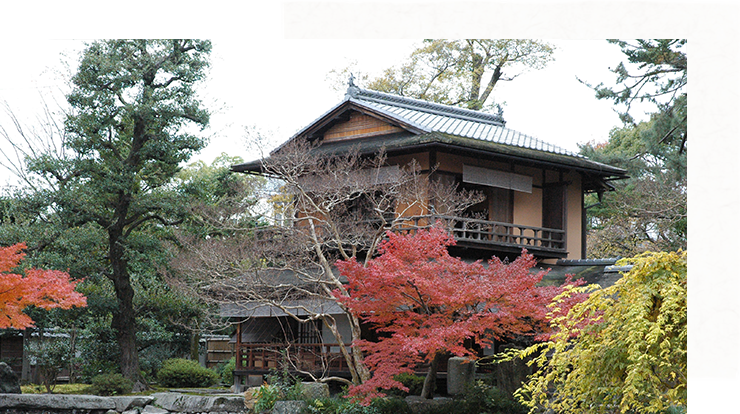From the Heian period to prosperity as a court nobles’ residential area,
followed by disrepair and then restoration
During the ancient period, Kyoto Basin, where Kyoto Gyoen National Garden is located, experienced frequent river flooding, resulting in the spread of vegetation consisting mainly of deciduous broad-leaved trees of the elm family (original vegetation of Kyoto). From the Heian period (794–1185), with the floodplain becoming smaller, the emperor’s residential palace was built at the site where Kyoto Gyoen currently lies. Later, residences of court nobles were constructed around the palace, forming the nobles’ residential area. The area became Japan’s center of power, and the culture of the nobles serving the emperor flourished.
In the Meiji era (1868–1912), the nobles’ residential area rapidly fell into disrepair following the events surrounding the 1868 Meiji Restoration in which the capital was relocated from Kyoto to Tokyo. Lamenting this situation, Emperor Meiji (1852–1912) conceived the idea for the Kyoto Gyoen Garden—Preservation Project to transform the residential area site into the outer garden of the Imperial Palace. Garden paths were laid, and trees were planted, including those donated by Kyoto residents and others from all over Japan. In the early years of the Taisho era (1912–1926), the garden underwent extensive renovations for the enthronement ceremony of Emperor Taisho (1879–1926). The wide orderly roads, paths through trees, and views of the mountains in all directions created the foundation for the landscape that exists today. It took 150 years until this forest area, the largest in Kyoto’s city center, was completed.
After World War II, the area was designated a National Garden for people to use day-to-day for strolls, sports, and the like. Remnants of the life and rituals of the Imperial Family (emperor), including the Imperial Palace, the landscape of its outer garden, and two of the three major festivals in Kyoto—the Aoi Matsuri (Hollyhock Festival) and the Jidai Matsuri (Festival of the Ages), demonstrate the various layers of history of Kyoto Gyoen.
Ancient Period to Early Modern Period
(1) Before the time when the Imperial Palace was built, Kyoto Basin experienced frequent river flooding resulting in an expanse of vegetation consisting mainly of deciduous broad-leaved trees of the elm family (original vegetation of Kyoto).
(2) The imperial palace in Heiankyo, the capital of Heian Japan (794–1185) in present-day Kyoto, was completed in 794. This imperial palace, established by Emperor Kanmu (737–806), was located about 2 kilometers west of the present Kyoto Imperial Palace. Due to repeated destruction of the palace by fire, the residences of regent families mainly served as temporary palaces of the emperor.
(3) The imperial palace was destroyed by fire and was never rebuilt in its original location. In 1227, the imperial palace was built in its present location.
(4) In 1331, Emperor Kogon (1313–1364) ascended the throne, and one of the temporary imperial palaces became the Imperial Palace.
(5) In 1392, the Northern and Southern Dynasties united, and the Imperial Palace, which had served as the residence of the emperor of the Northern Dynasty, became the main seat of the emperor in both name and reality. The Imperial Palace then served as the residence of the emperor for about 500 years until the Meiji era (1868–1912).
(6) From the Azuchi-Momoyama period (1568–1603) to the early years of the Edo period (1603–1867), a court nobles’ residential area was established around the Imperial Palace. Following the Great Fire of Hoei in 1708, which destroyed merchants’ houses in the southern part of the area, the estates of nobles’ residences were extended to the site and the size of the nobles’ residential area expanded.
Back to timeline
Modern Period
(7) When Emperor Meiji (1852–1912) moved to Tokyo, the nobles in Kyoto also relocated to Tokyo. Along with changes brought about following the 1868 Meiji Restoration, the court nobles’ residential area rapidly fell into disrepair.
(8) In 1877, Emperor Meiji, concerned about the disrepair of the court nobles’ residential area, ordered Kyoto Prefecture to preserve the Imperial Palace and maintain its original grandeur.
(9) In 1883, the Kyoto Gyoen Garden—Preservation Project was completed, including demolition of the residences, construction of earth and stone walls around the perimeter of the garden, road construction, and tree planting.
(10) In 1914, repair work was conducted as part of preparations for the enthronement ceremony for Emperor Taisho (1879–1926), including the widening and improvement of Kenreimon-odori Avenue. The present Kyoto Gyoen was almost complete.
Back to timeline
Contemporary Period
(11) In 1947, a cabinet decision was taken to make Kyoto Gyoen a National Garden. This designation gave the garden the role of maintaining the landscape of the front garden of the Imperial Palace and serving as an urban park.
(12) In 1949, Kyoto Gyoen opened to the public as a National Garden and attracted many visitors. In 1951, tennis courts, the Children’s Park, and other facilities were installed.
(13) In 1971, jurisdiction changed from the Ministry of Health and Welfare to the Environment Agency, and importance was attached to the new role of promoting interaction with nature. The Demizu Stream was created in 1981 and the “Haha-to-ko-no-mori” Nature-Study Forest Park in 1986.
(14) In 2005, the Kyoto State Guest House was completed on the site of the former banquet hall, which had been built for Emperor Showa’s enthronement ceremony. Many dignitaries from overseas have since been welcomed at the Kyoto State Guest House.
Back to timeline





